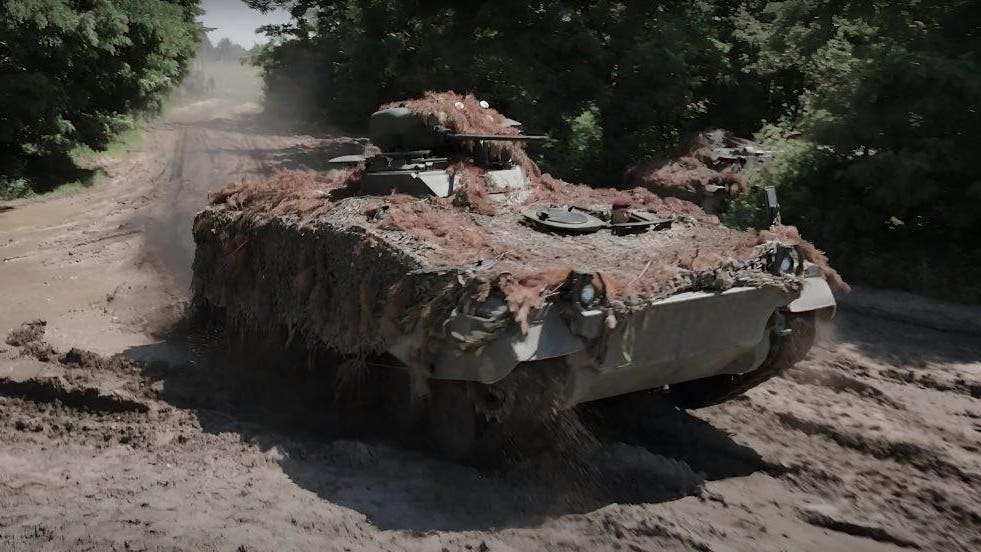Ukrainian brigades have breached the main Russian defensive line west of Verbove, north of Tokmak along the 50-mile axis stretching south to occupied Melitopol in southern Ukraine’s Zaporizhzhia Oblast.
Marder, Stryker and BMP infantry fighting vehicles belonging to the 82nd Air Assault Brigade and adjacent units in recent days rolled over the outermost trench, threaded through concrete “dragon’s teeth” anti-tank obstacles and pushed toward Verbove, where three Russian regiments plus attached special operations forces and reservists are fighting a frantic defensive action.
Breaching the first layer of the so-called “Surovikin Line”—a three-tiered network of mines, obstacles and earthworks named for its designer, disgraced Russian army general Sergey Surovikin—was hard for the Ukrainians. What happens next might be harder.
The Ukrainian vehicle crews and infantry who penetrated the Surovikin line on or before Wednesday found themselves on open ground stretching from the main outer trench to the outer edge of Verbove over a distance of a mile. There’s nothing between that trench and Verbove but fields, a few artillery-shredded treelines and trenches full of live, or recently-dead, Russians.
That is to say, there’s almost no cover. To enter Verbove and shelter in its westernmost buildings, to say nothing of liberating the settlement, Ukrainian troops must march east for at least a mile while in full view of Russian drones, and within easy reach of both the drones’ tiny bombs and the artillery the drones help to spot.
No one pretends it will be easy. “We are pushing through,” one Ukrainian officer told The Wall Street Journal. “We are destroying them. But the price … ”
Ukrainian losses are heavy and surely will get heavier. Russian artillery struck a Ukrainian Stryker, which carries up to 11 infantry and crew. A drone blew up a Ukrainian BMP fighting vehicle while an infantry squad rode atop it, sending the survivors scurrying for cover in a nearby treeline. Exhausted Ukrainian infantry resting in a Russian trench they had captured came under attack by Russian first-person-view racing drones carrying grenade-size explosives.
There’s no hiding between the Surovikin Line and Verbove. The Russian bombardment ends when the Ukrainians clear the settlement and extend their artillery and drone coverage far enough to suppress the Russians’ own artillery and drones.
Ukrainian soldier Olexandr Solon’ko warned it would be like this. “Environment: steppe, fields, tree lines,” he wrote about southern Ukraine. “Slight elevations and dips, villages, small rivers. Minefields. Whoever you may be, an armored assault group, evacuation team, aerial or infantry reconnaissance, your movement is visible from afar.”
“The enemy has long been preparing,” Solon’ko wrote. “Equipment and personnel can be spotted from a distance and targeted. Both sides understand that there are limited places for positions and deployment. Most likely, there’s something to shoot at in almost every tree line.”
When the Ukrainians succeed in capturing a Russian position, the bombardment only intensifies—as Russian aircrews and artillery gunner pre-registered those same positions for attack on the assumption they might fall to the Ukrainians.
The Russian air force’s satellite-guided glide bombs—some weighing more than 3,000 pounds—scare the Ukrainians the most, Solon’ko claimed. A single KAB bomb can blast a hole tens of feet deep and kill unprotected infantry from hundreds of feet away. “Bombs are not spared,” he warned.
For all the dangers they must face first breaching a fortification and then crossing the adjacent open terrain, the Ukrainians at least know how to do it. Before the 82nd Brigade and the other units fighting along the Melitopol axis—including the 46th Air Mobile Brigade and the 47th Mechanized Brigade—could assault Verbove, they first had to liberate Robotyne, just a few miles to the northwest.
Robotyne’s earthworks were nearly as daunting as Verbove’s are. To get through and past them, Ukrainian troops let their artillery lead the way—then moved out on foot. They advanced slowly, carefully calculating the likely cost of capturing the next Russian position.
“For those who are overly smart and believe that the Ukrainian armed forces took an incredibly long time to drive the Russians out of the village of Robotyne, they must have missed the defense system that needed to be overcome in order to push the Russians away,” Solon’ko wrote. “Truly, a monumental task has been accomplished.”
The next monumental task—liberating Verbove—at least has the full attention of the Ukrainian armed forces’ 9th Operational Corps, a powerful formation that includes many of the best-equipped brigades on the southern front. In the weeks they fought for Robotyne, the southern brigades held back much of their armor, saving it for exactly the opportunity that presented itself when the first battalions breached the Surovikin line in recent days.
Where before the Ukrainians might have advanced on foot, now they’re riding in their best Marder and Stryker fighting vehicles.
Yes, they’ll lose many of them. But if the vehicles work as designed, they’ll protect their crews and passengers from all but the most catastrophic attacks. “Armor serves a specific purpose that entails risks,” Solon’ko explained. “These actions are justified by the fact that they save lives.”
Even when their Strykers and Marders burn, the infantry may live to keep fighting—across that mile of open ground to Verbove.
Read the full article here





